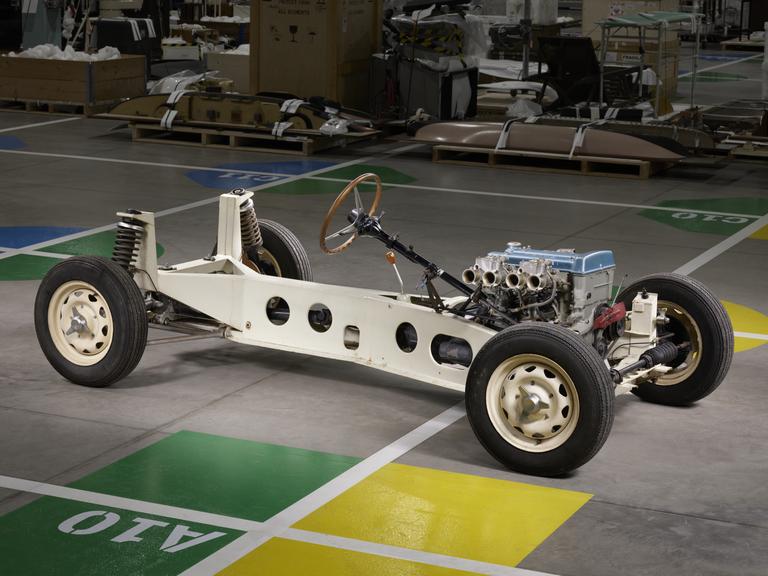
Lotus Elan Car Chassis
- Made:
- 1966 in United Kingdom




This Lotus Elan Car chassis was built in 1966 by Lotus Car Ltd in Great Britain. This car chassis is specifically built for the original series of Lotus Elan cars that were designed and built between 1962-75 and was likely used for the Elan S2 Se or Elan S3 SE variants.
The backbone chassis itself is made of steel and painted white. Mounted onto the chassis are four steel wheels each with New Dunlop 145.13 tires and hydraulically operated disc brakes. Behind the front two wheels is a set of double wishbone suspensions over a torsion bar. Behind the rear wheels are a pair of Chapman strut suspensions, and the wheels are connected by an aluminium alloy differential gear train.
The engine is a 1558cc Lotus-Ford Twin Cam in-line four, mounted at the centre-front of the chassis, and connected to the engine are two Weber DCOE side-draft carburetors.
Developed as a stylish successor to the Lotus Elite, the first series of Lotus Elan’s were two-door roadsters/coupes with rear-wheel drive that were designed and produced by Lotus Cars Ltd between 1962 and 1975. Whilst Lotus Cars Ltd was renowned for producing racing cars, the Elan was expressly designed to be affordable and appealing to a wider commercial base. As a result, the Lotus Elan became the first major commercial success for the company.
Lotus Elans were the first Lotus cars to use a backbone chassis, the purpose of which was to support a much lighter fibreglass car body. This reflected the minimal weight design philosophy that Lotus Cars Ltd promoted. The Elan’s design included four-wheel independent suspension with a combination of front mounted double wishbone suspension, and back mounted Chapman strut suspension. This suspension design offered the driver sharp and agile steering control whilst maintaining the quality of the ride.
This specific chassis was built in 1966 for a ‘Special Equipment’ (abbreviated S/E) variant of either the Elan S2 or Elan S3. These models came with more highly tuned and powerful variants of the technologically advanced Lotus-Ford Twin Cam in-line four engine. This SE engine had a larger 1558 cc capacity and could produce 115 brake horsepower. With this engine, a Lotus Elan could accelerate to 100 mph in 21 seconds to a maximum speed of 122 mph, making it one of the swiftest consumer sportscars of the 1960s.
The Lotus Elan has become one of the UK’s most recognisable car designs. Fans of the 1960s show The Avengers will remember the Lotus Elan being driven by the equally modern Emma Peel portrayed by iconic British actress Diana Riggs. The Lotus Elan represented the character’s independence and resourcefulness, challenging the stereotype in British media that women were ‘secondary characters’.
Details
- Category:
- Road Transport
- Object Number:
- 1967-8
- Materials:
- steel (metal), aluminium (metal), rubber (unidentified), wood (unidentified), glass and plastic (unidentified)
- Measurements:
-
overall: 1110 mm x 1460 mm x 2790 mm,
- type:
- car
- credit:
- Lotus Cars (Sales) Ltd.




